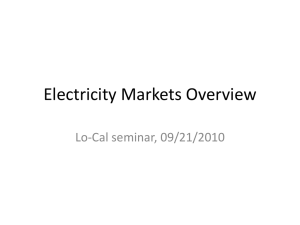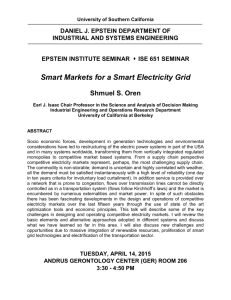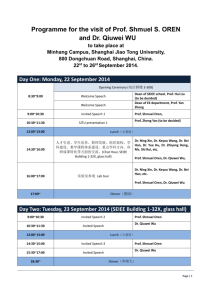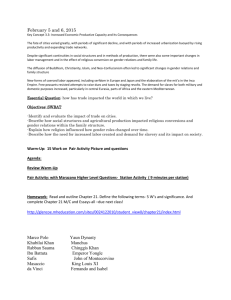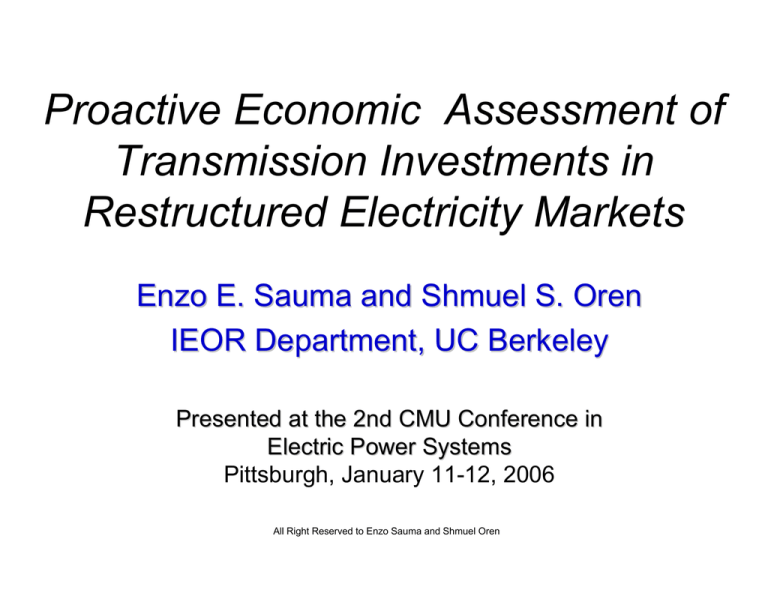
Proactive Economic Assessment of
Transmission Investments in
Restructured Electricity Markets
Enzo E. Sauma and Shmuel S. Oren
IEOR Department, UC Berkeley
Presented at the 2nd CMU Conference in
Electric Power Systems
Pittsburgh, January 11-12, 2006
All Right Reserved to Enzo Sauma and Shmuel Oren
Motivation
• Integrated resource planning is no longer viable
in a restructured electricity industry
• Generation investment and operating decisions
are driven by economic motives
• While most transmission investments are
motivated by reliability considerations such
investment impact the economic outcomes for
market participants creating winners and losers
• The market outcomes of transmission
investment are affected by market power which
may circumvent intended gains from trade
All Right Reserved to Enzo Sauma and Shmuel Oren
Economic Objectives in
Transmission Investment
• Maximize social welfare
• Minimize the local market power of the agents
participating in the system
• Maximize consumer surplus
• Maximize producer surplus
These objective may conflict with each other
All Right Reserved to Enzo Sauma and Shmuel Oren
Illustrative Example
Demand:
P1(q1) = 50 – 0.1 q1
Node 1
Node 2
One generator,
many consumers
500 MW Cap. Limit
MC of generation:
MC1 = c1 = $25/MWh
Demand:
P2(q2) = 100 – q2
Many generators,
many consumers
MC of generation:
MC2(q2) = 20 + 0.15 q2
We want to evaluate the optimal network structure under
different optimization objectives
All Right Reserved to Enzo Sauma and Shmuel Oren
Impact of
Connectivity
Substitution effect
Competion effect
SSNS equilibria
ATCS equilibria
SSNS equilibria
ATCS equilibria
All Right Reserved to Enzo Sauma and Shmuel Oren
Winners and Losers
Effects of
building a line
with adequate
capacity between
both nodes:
∆PS = – $ 19,
∆CS = – $ 1,
∆W = – $ 20 *
•
•
The expansion decision that minimizes local market power of generators
may differ from the decisions that maximizes social welfare, maximizes
consumer surplus, and maximizes producer surplus.
The “winners” from the transmission investment (consumers at node 1 and
generators at node 2) can be expected to expend up to the amount of rents
that they stand gain on this expansion project to promote it although it
reduces social welfare.
All Right Reserved to Enzo Sauma and Shmuel Oren
Sensitivity to Cost at Node 1
•
•
•
Different
objectives
could lead to
different
network
expansion
Decisions
Optimal
network
expansion
depends on
cost structures
of generators
All Right Reserved to Enzo Sauma and Shmuel Oren
Implications for Economic
Assessment of Transmission
Upgrades
• Transmission upgrades may create winners and
looser
• Valuation of an upgrade may be different for different
stakeholders
• Value of an upgrade is sensitive to generation cost
• Value of an upgrade is affected by market outcomes
and may be preempted by exercise of market power
• Value of an upgrade will be affected by generation
investment response
• Transmission planning can influence generation
investment
All Right Reserved to Enzo Sauma and Shmuel Oren
Proactive Transmission
Investment Model
Model Assumptions:
Network planner evaluates
different transmission
expansion projects
Generators’
marginal cost curves
rise smoothly
All Right Reserved to Enzo Sauma and Shmuel Oren
Nash-Cournot competition
using a lossless DC
approximation of
Kirchhoff’s laws
Model Formulation
Period 3: Spot Market - LCP
Max
Firm G
{qi , i ∈ NG}
c
∑{P (q
πG c =
i
i∈NG
c
i
c
+ ric) ⋅ qic – CPic (qic, gic)}
qic ≥ 0 , i ∈ NG
s.t.
Jointly
Max
System
Operator
s.t.
{ric, i ∈ N}
∆W =
c
∑
i∈N
⎛ r ic
⎜
c(q c + x ) dx
P
i
i
i
i
⎜⎜
⎝0
∑ ∫
i∈N
ri c = 0
– flc ≤
∑ φl,i c ⋅ ric ≤
i∈N
⎞
⎟
⎟⎟
⎠
solving
KKT
conditions
flc , ∀ l ∈ L
qi c + r i c ≥ 0 , ∀ i ∈ N
All Right Reserved to Enzo Sauma and Shmuel Oren
Model Formulation
Period 2: Strategic generation investment - EPEC
Firm G
Max
{gi , i ∈ NG}
s.t.
Ec[πG c] –
∑
{ CIGi (gi, gi0) }
i∈NG
KKT conditions of period-3 problem
All Right Reserved to Enzo Sauma and Shmuel Oren
Model Formulation
Period 1: Transmission investment - MP EPEC
Proactive
Network
Planner
(PNP)
Max l, f
l
⎧
⎪
∑ ⎨ Ec
i∈N ⎪
⎩
⎡
⎢
⎢⎣
qic + ric
∫
Pic(q)
dq –
CPic(qic,
gic)
0
⎤ ⎫⎪
⎥⎬
⎥⎦ ⎪⎭
– ∑ {CIGi (gi, gi0)} – CIl(fl , fl0)
i∈N
s.t.
KKT conditions of period-3 problem
and all optimality conditions of period-2 problem
All Right Reserved to Enzo Sauma and Shmuel Oren
Models Comparison
•
Proactive Network Planner (PNP) model: The
network planner proactively plans transmission investments
to induce a more socially-efficient equilibrium of generation
investments.
•
Reactive Network Planner (RNP) model: The
network planner plans transmission investments only
considering the currently installed generation capacities.
•
Integrated-Resources Planner (IRP) model: The
network planner jointly plans generation and transmission
expansions, although the energy market operation is still
decentralized.
•
Fully-Vertically-Integrated Social Planner (FVISP)
model: The social planner jointly plans and operates both
the generation and the transmission sectors.
All Right Reserved to Enzo Sauma and Shmuel Oren
Models Comparison
Integrated-Resources
Planner (IRP) model
Reactive System
Operator (RSO) model
Period B ≡ period 3 of PSO model
Periods b and c ≡ periods 2 and 3 of
PSO model
Period A:
Period a:
Max { g i }, A,
fA
⎧ ⎡ qic + ric
⎤⎫
⎪ ⎢
c
c c
c ⎥⎪
∑ ⎨Ec ⎢ ∫ Pi (q) dq − CPi (qi , g i )⎥ ⎬
i∈N ⎪
⎦ ⎪⎭
⎩ ⎣ 0
−
∑ {CIGi(g i ,g i0 )}
i∈N
s.t.
Max A, fA
−
− CI A( fA ,f A0 )
KKT conditions of period B problem
⎧ ⎡qic + ric
⎤
⎪ ⎢
c
c c
c ⎥
∑ ⎨ Ec ⎢ ∫ Pi (q) dq − CPi (qi , g i )⎥
i∈N ⎪
⎦
⎩ ⎣ 0
∑ {CIGi(g i ,g i0 )}−
i∈N
s.t.
CI A( fA ,f A0 )
KKT conditions of period c problem
g i = g i0
All Right Reserved to Enzo Sauma and Shmuel Oren
, ∀ i∈N
⎫
⎪
⎬
⎪
⎭
Models Comparison
Proposition: The optimal expected social
welfares obtained from the PNP, RNP, IRP
and FVISP models have always the following
order:
SWRNP ≤ SWPNP ≤ SWIRP ≤ SWFVISP
All Right Reserved to Enzo Sauma and Shmuel Oren
Case
Study:
30-bus
Cornell
Network
Six Generation
firms (each owning
generation capacity
at a single node)
39 Transmission
lines
All Right Reserved to Enzo Sauma and Shmuel Oren
Case Study
All Right Reserved to Enzo Sauma and Shmuel Oren
Case Study
CIGi (gi , gi0) = 8⋅ (gi – gi0)
All Right Reserved to Enzo Sauma and Shmuel Oren
Case Study Results
All Right Reserved to Enzo Sauma and Shmuel Oren
Case Study Results
PNP model:
All Right Reserved to Enzo Sauma and Shmuel Oren
Case Study Results
RNP model:
All Right Reserved to Enzo Sauma and Shmuel Oren
Case Study Results
IRP model:
All Right Reserved to Enzo Sauma and Shmuel Oren
Case Study Results
FVISP model:
All Right Reserved to Enzo Sauma and Shmuel Oren
Conclusions
• We evaluated the social welfare
implications of transmission investments
based on equilibrium models characterizing
the competitive interaction among
oligopolistic generation firms.
• We illustrated that, although a PNP cannot
do better (in terms of expected social
welfare) than an IRP, it can recoup some of
the lost welfare by proactively expanding
transmission capacity.
All Right Reserved to Enzo Sauma and Shmuel Oren
Conclusions
• We also illustrated that the valuations of
transmission expansion projects made by a
PNP can differ from the valuations made by
a RNP.
• We illustrated that, when valuations of
transmission expansion projects are
different under the PNP and the RNP
models, a PNP could make more socially
efficient transmission expansion decisions
than its reactive counterpart.
All Right Reserved to Enzo Sauma and Shmuel Oren
Questions?
All Right Reserved to Enzo Sauma and Shmuel Oren

